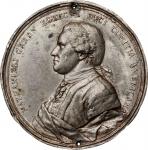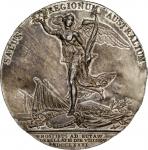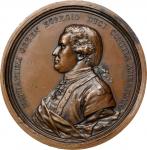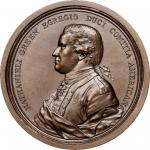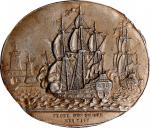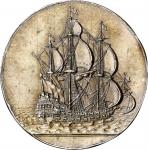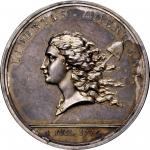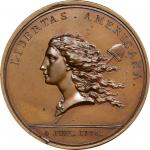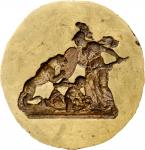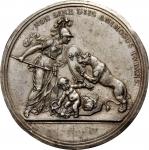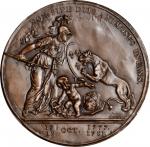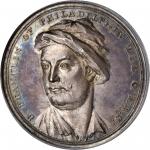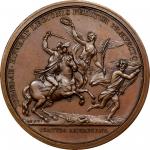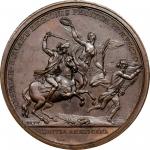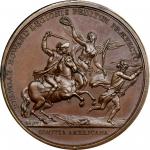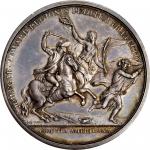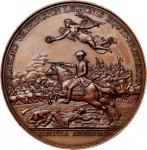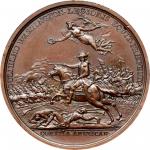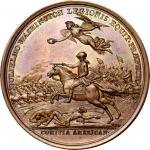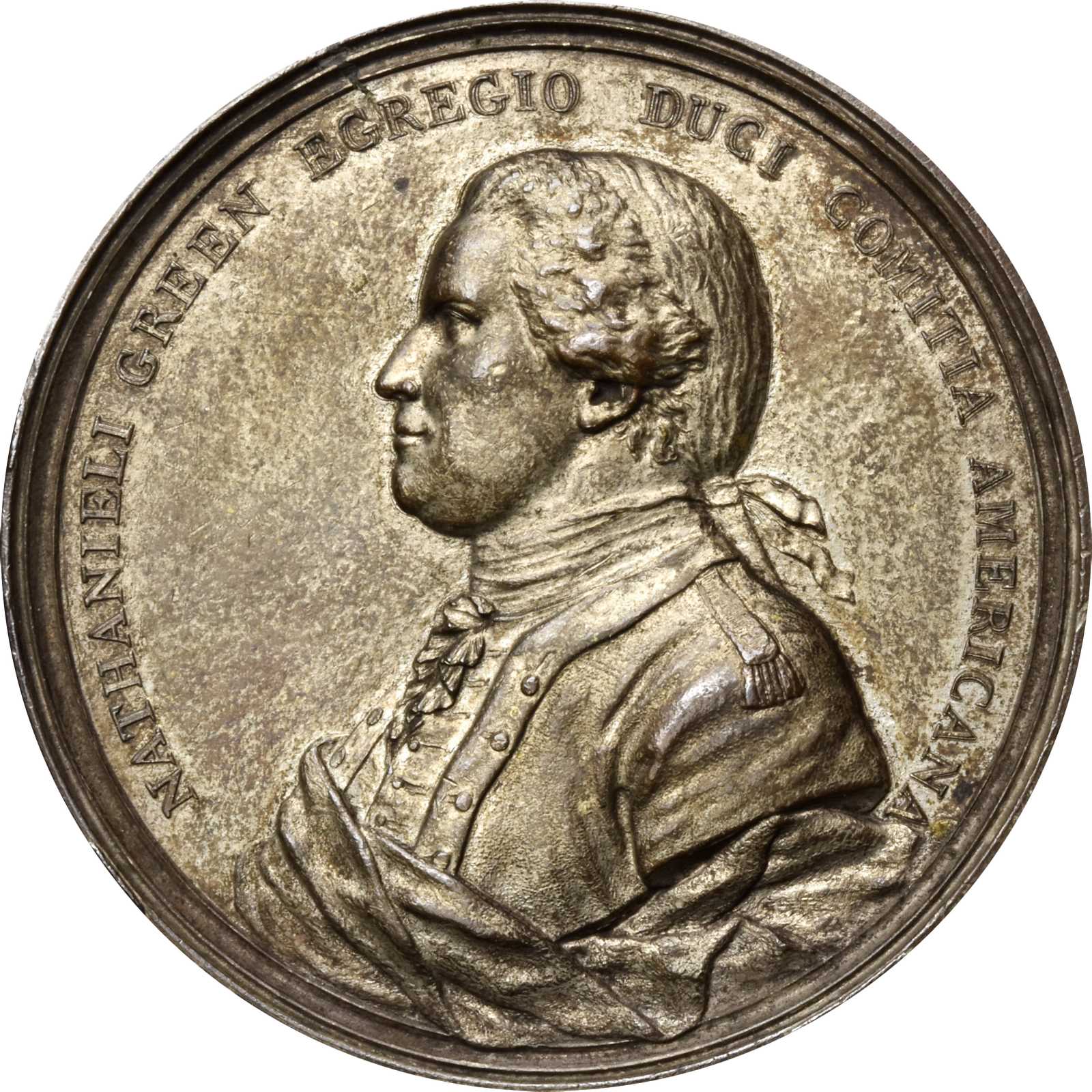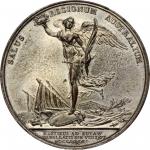1781 Nathanael Greene at Eutaw Springs medal. Betts-597. Copper, tinned. Original. Paris Mint. 57.0 x 56.7 mm, 1167.6 grains. 4.2 - 4.7 mm thick. Extremely Fine.Plain concave edge, witness lines or collaring marks near 9:00 relative to the obverse. An unusual and important example of this rarity. Apparently struck three times, with significant spread among the multiple strikes visible among the legends of the obverse, an overstep during production that caused the planchet to split near 11:00 on the obverse and has made this specimen a full millimeter broader than other examples studied. The surfaces are silver-gray with underlying copper tones, and some trivial surface granularity, all byproducts of the process by which this piece was "silvered" or coated in tin to give it a silvery appearance. The detail is superb on both sides, the silvering nearly complete (if thin), and no substantial defects are seen, just a few marks and a single long vertical scratch in the left reverse field. The edge shows some marks and scratches, invisible from either side. Other Greene medals studied, including the 2001 LaRiviere specimen and the 2011 Lt. Col. Lewis Morris example, had similar business on the edges, suggestive of an ill-fitting and amateurish collar. This specimens semi-broadstruck nature and planchet split further the suspicion of these striking problems. Alan Stahl described "vise marks" on the ANS specimen, apparently an indication of the same phenomenon.<p>The obverse shows two small rim cuds, one below NA of NATHANIELI, another above LI of that word. The tiny raised lumps left from die spalling along the internal rim below M of REGIONUM match those seen on the Massachusetts Historical Society silver piece, as well as others seen. Reverse buckling, seen atop the flags and left of Victorys midsection, is distinctive; this reverse die must have failed very quickly indeed, as it was never again put into use after 1787.<p>The original dies for this medal apparently struck fewer than 30 medals: Greenes own gold, Washingtons silver, and 23 specimens in bronze that were transported to the United States along with the dies in 1787. A silver example is in the enigmatic (but nearly complete) set in the collection of Viennas Kunsthistoriches Museum. Another silver one was sold in the June 1855 Bangs sale that has since disappeared into the ether; perhaps this example was once more convincingly silver in appearance?<p>The copper medals, like this one, that were sent to the United States in 1787 had a very particular purpose, as enunciated by a resolution of the Continental Congress of October 26, 1787: "Ordered that the Secretary of the United States for the Department of foreign Affairs transmit one of the copper medals struck in Honor of General Greene to each of the said Generals Aides, who acted during his Command in the Southern Department." John Jay sent one such aide, Lt. Col Lewis Morris, a copper medal in February 1788. Apparently delayed by ill health since the October 1787 resolution, he wrote to Morris:<p><em>It gives me pleasure to have an opportunity of transmitting to you, by Order of Congress, a copy of the Medal struck by their Direction in Honor of the late General Greene. A variety of circumstances conspire to render this mark of public attention acceptable to you, though I am persuaded that none among them will more immediately affect your Feelings than the Relation it bears to that great Man whose loss you in particular and the people of America in general have great Reason to regret and lament.</em><p>Presumably all or most of the 23 copper specimens were distributed similarly. Most of those seen show evidence of non-numismatic handling, indicating that these pieces were not struck for museum collections or contemporary numismatists, but for distribution to a non-collector audience.<p>Though the Maryland Historical Society reported having one in 1850, and the New York State Library inventoried one in 1857 (along with obverse and reverse cliches), the earliest auction appearance of a copper Greene medal appears to have been Ed Cogans sale of January 1876. In the description of lot 844, which he described as "a trifle nicked," the so-called Godfather of the American Coin Trade noted it was "the only original medal I remember to have offered for years." It brought $33, an alarmingly high sum. The piece in Henry Sampsons February 1884 sale was reserved at $25, again an extremely strong price indicative of a great rarity. The one W. Elliot Woodward offered in the January 1881 Jenks sale, lot 1491, was described as bronze but brought only $1.60, assuring modern scholars that the piece was detected as an electrotype.<p>Interestingly, this is not the only silvered example known. Bushnell (1882) lot 1625 sold for $37 to Cogan for Richard Winsor. It sold again in the 1895 Winsor sale (lot 1269) for $30, then reappeared in the W.W.C. Wilson sale as lot 812 for $56. With its distinctive scratches, it is most assuredly a different piece. Its current whereabouts are unknown.<p>Other examples sold in the 1933 Senter sale, where the piece tossed into the large group sold as lot 24 was noted as "a struck medal and original" in Henry Chapmans personal copy; Chapman bought the lot. Henry Chapman also handled one in the 1914 George W. Parsons sale, lot 2137. His brother Samuel Hudson Chapman was the buyer at $27. The only one S.H. Chapman ever sold at auction (perhaps the same piece?) was offered in June 1917, lot 645, described as one of four known and "never restruck or counterfeited by our mint."<p>When LaRivieres sold in 2001, bringing $14,950 despite its cleaning, none had been offered in a generation. Fords triplicate offering (!) represented more than 10% of the entire mintage in copper - and a centurys worth of held-back inventory. The Adams and Bentley census lists 12 pieces in this composition, half of which are impounded: American Numismatic Society, Smithsonian Institution, British Museum, Colonial Williamsburg Foundation, Boston Public Library, and the Rhode Island Historical Society. One of the six held privately (Census #8) was discovered by Mr. Adams to be an electrotype; it is included in this sale. The LaRiviere piece and the Lt. Col. Lewis Morris piece (from our September 2011 sale at $86,250) do not appear on the list, leaving a census of privately held at seven pieces. The most recent auction offering, our August 2012 sale of the example previously sold as lot 223 in Ford XIV, brought $44,062.50.<p>The Adams example, pedigreed to Bowers and Ruddys New York Public Library sale, may trace its provenance back to the heart of the former NYPL collection: the cabinet formed by Thomas Addis Emmet in the mid-19th century, This appears to be only its second recorded auction appearance.<p><strong>The Battle of Eutaw Springs</strong><p><strong>The Action:</strong><p>After Guilford Court House turned into a draw that was too costly for Cornwallis to do anything but regroup far to the east, Nathanael Greene turned south. Washingtons most trusted former deputy continued his plan to harass and divide the British forces that remained in South Carolina, by picking his spots and ensuring that resupply and communication lines with British-held Charleston were difficult to maintain. He met British commander Lord Rawdon back in Camden, where a young ruffian named Andrew Jackson was being held prisoner. Greene suffered a mild defeat at the indecisive Battle of Hobkirks Hill in April 1780. Rawdon evacuated Camden soon thereafter, knowing he was surrounded by American Continentals and local militia on all sides. Greene turned inland, meeting a newly reinforced force under Rawdon at Ninety-Six on the Carolina frontier in June 1780. The summer passed quietly. Rawdon returned to Charleston, then left for England - and was captured by deGrasse at sea. Lt. Col. James Stewart was left in charge of the British military presence in South Carolina. Nathanael Greene regained strength, attracted reinforcements, and waited.<p>His moment to strike came during the dog days of late August. Francis Marion, the legendary Swamp Fox, found his way to Greenes position, meeting forces under Lt. Col. Light-Horse Harry Lee (a Comitia Americana medal recipient for Paulus Hook), militia under General Andrew Pickens, and the seasoned troops commanded by Comitia Americana medal recipients Lt. Col. John Eager Howard and Lt. Col. William Washington. Greene took more than 2,000 men onto the field at Eutaw Springs, most of them well experienced and ready to fight.<p>Stewarts regulars and loyalists were almost as numerous as Greenes forces when they first encountered each other on the morning of September 8. Loyalist Capt. John Coffin, a Boston native (whose brother Sir Isaac Coffin was responsible for the [1827] Tristram Coffin medal cataloged as Betts-533), was the first to find the Patriot forces, while out on the morning forage. By 9 AM, battle lines had formed. Before long, both sides were disorganized and scattered. William Washington had fallen prisoner into British hands. By the time the smoke cleared, Greene had taken more than 500 British prisoners as well. Both sides held portions of the field when the skies opened with rain, and both had lost dozens of dead and a couple hundred wounded. Stewart withdrew to a position closer to the coast. Greene controlled the interior. <p>The battle had been something of a draw, but Greenes strategy had won. He had kept Cornwallis Southern force divided and occupied British attention in the Carolinas. He kept his army together, and he controlled most of inland South Carolina. As Greene played cat and mouse in the Southern Department, Cornwallis marched to his doom in Virginia. He arrived in Yorktown on August 1, a month before Eutaw Springs. When Greenes army left the field on September 8, the French Navy had taken control of the Chesapeake, sailed up the James River, and essentially sealed Cornwallis fate. Within a week, Washington and Lafayette arrived on Virginias Middle Peninsula. The game was up. Greene had played his part flawlessly, and helped assure American victory. Congress voted him a gold medal barely a week after Cornwallis laid down his arms for the last time.<p><strong>The Resolution:</strong><p><em>Resolved, That the thanks of the United States in Congress assembled, be presented to Major General Greene, for his wise, decisive and magnanimous conduct in the action of the 8th of September last, near the Eutaw Springs, in South Carolina; in which, with a force inferior in number to that of the enemy, he obtained a most signal victory over the British army commanded by Colonel Stewart:</em><p><em>That the thanks of the United States in Congress assembled, be presented to the officers and men of the Maryland and Virginia brigades, and Delaware battalion of continental troops, for the unparalleled bravery and heroism by them displayed, in advancing to the enemy through an incessant fire, and charging them with an impetuosity and ardor that could not be resisted:</em><p><em>That the thanks of the United States in Congress assembled, be presented to the officers and men of the legionary corps and artillery, for their intrepid and gallant exertions during the action:</em><p><em>That the thanks of the United States in Congress assembled, be presented to the brigade of North Carolina, for their resolution and perseverance in attacking the enemy, and sustaining a superior fire:</em><p><em>That the thanks of the United States in Congress assembled, be presented to the officers and men of the state corps of South Carolina, for the zeal, activity and firmness by them exhibited throughout the engagement:</em><p><em>That the thanks of the United States in Congress assembled, be presented to the officers and men of the militia, who formed the front line in the order of battle, and sustained their post with honor, propriety and a resolution worthy of men determined to be free.</em><p><em>Resolved, That two pieces of field Ordnance be presented to Major General Greene by the Commander in Chief, with a motte engraved "from the United States in Congress Assembled to Major Genl. Greene, in honour of the Victory obtained under his Command near the Eutaw Springs in So Carolina on the 8th. September A. D. 1781.</em><p><em>Resolved, That a Sword be presented to Colo Williams of the Maryland line for his great military skill and uncommon exertions on this occasion.</em><p><em>Resolved, That a British standard be presented to Major General Greene, as an honorable testimony of his merit, and a golden medal emblematical of the battle and victory aforesaid:</em><p><em>That Major General Greene be desired to present the thanks of Congress, to Captains Pierce and Pendleton, Major Hyrne and Captain Shubrick, his aids de camp, in testimony of their particular activity and good conduct during the whole of the action:</em><p><em>That a sword be presented to Captain Pierce, who bore the generals despatches, giving an account of the victory, and that the Board of War take order herein.</em><p><em>Resolved, That the thanks of the United States in Congress assembled, be presented to Brigadier General Marion, of the South Carolina militia, and the officers and men under his Com for his wise, gallant and decided conduct, in defending the liberties of his country; and particularly for his prudent and intrepid attack on a body of the British troops, on the 30th day of August last; and for the distinguished part he took in the battle of the 8th of September.</em><p><em>- Continental Congress Resolution of October 29, 1781</em><p><em></em><strong>The Acquisition:</strong><p>Even though Greenes heroic actions at Eutaw Springs were the latest to earn the honor of a Congressional medal, his medal was the second one delivered, following only the one Franklin finished so quickly for De Fleury and Stony Point. Franklin finished only that first effort; David Humphreys bested him by one, seeing only this medal and the one for Horatio Gates through to completion.<p>It was a coup that Humphreys was able to hire the uber-talented Augustin Dupre to accomplish Greenes medal. It would be the first of three Comitia Americana medals Dupre would engrave, followed by the medals for Morgan and Jones, though Dupre would gain lasting American fame for his Libertas Americana medal. <p>On November 19, 1785, Humphreys and Dupre signed a contract for the completion of the Nathanael Greene medal, requiring Dupre to produce an obverse depicting a portrait of General Greene and a reverse with "Victory treading under her feet broken arms, with the legend and the exergue," strike 24 medals exactly, and deliver the dies and medals to Humphreys upon their completion. John Adams, holding the Congress European pursestrings in Paris, wrote home to John Jay to report "Humphreys brought with him, an order upon Mr Grand for Money to pay for a Medal to be Struck for each of the Generals Washington, Gates and Green … As We Supposed it to be the Undoubted Intention of Congress that these Small Presents should be made in honour of those great Events and immortal Actions, I consented to draw for the Money upon the Same Bankers to the Amount of about a Thousand Pounds. this also I hope will meet the Approbation of Congress."<p>Dupre ran into a few snags along the way. He asked Humphreys to get him a new likeness of Greene after the painted miniature wasnt working as proper inspiration for an engraved profile portrait. Humphreys passed the request along to Secretary of War Henry Knox in May 1786. The lengthy delay Humphreys tolerated from Dupre was apparently one of the principal reasons it fell to Duvivier, not Dupre, to accomplish General Washingtons medal, the first authorized and ostensibly most important Comitia Americana medal of them all.<p>A year passed, during which Humphreys left Paris. Thomas Jefferson took over, and on February 14, 1787, he wrote to John Jay that he was in receipt of Greenes gold medal, 23 examples in bronze, and the dies, which he reported he had "sealed up" and "shall retain till I am honored with [Congresss] orders." A month later, Jeffersons secretary William Short packed up the lot and sent them home, with an update for John Jay:<p><em>Agreeably to Mr.: Jeffersons directions on his leaving Paris, I have the honor of forwarding to Your Excellency, the medal engraved for Genl. Greene, under the resolution of Congress. There is one of gold and twenty three of bronze, all of which are committed to the care of Mr. Walton of New York, who sails in the French Packet the 25th. of this month. The medal for Genl. Gates ordered by Congress and contracted for by Colo. Humphries is not yet finished; but will certainly be in time to be sent by the May Packet.</em><p>Alas, Greene had passed to his reward on June 19, 1786. <p>The Presentation:<p>Like John Stewart, Nathanael Greenes passing before his medal was completed required Congress to find a next of kin to whom his medal could be presented. The gold medal and its dies arrived in the United States and were delivered into the hands of Arthur St. Clair, the President of Congress on July 6, 1787. On August 9, St. Clair sent the gold medal to Jeremiah Wadsworth, the famous Connecticut financier and patriot who served as Greenes executor. <p>St. Clairs letter was sold as lot 378 in Stan V. Henkels April 1891 sale of Washington Relics consigned by Lawrence Washington, Bushrod Washington, and Thomas B. Washington, though how the letter came to be in their possession is unclear. The catalog excerpts the letter as follows:<p><em>It is much to be regretted, and l do most sincerely regret, that General Greene did not survive to receive this further testimony of the sense his country had of his services, particularly of the gallant action at the Eutaw. The memory of it, however, will be thereby long preserved, and it cannot fail to be very acceptable to his family. And when the story is related to his children, and the design of the medal explained to them, as it will be, whilst their veneration for their father is increased, a sense of gratitude and affection for their country, thus careful to accord his Glory, must be raised in their tender minds, and the generous resolution instantly formed to step forward in its service in the same honorable faith, should it ever be necessary, with the honest hope of meriting like rewards.</em><p>The paper trail goes silent after that, though most sources agree that Wadsworth passed the medal along to Kitty Greene, the generals fetching young widow, then just 32 years old. Julian appears to be the only source for the claim that Wadsworth also presented Ms. Greene the original dies. Whether she received the dies or not, they have not been seen since. Greenes gold medal survives, the property of the state of Rhode Island, on deposit at the Rhode Island Historical Society.<p><strong>The Nathanael Greene at Eutaw Springs Medal:</strong><p><strong>Obverse: </strong>A portrait of Greene in profile facing left, wearing his military uniform but also draped (a symbol of his recent passing?), surrounded by the legend NATHANIELI GREEN EGREGIO DUCI COMITIA AMERICANA or "To Nathanael Greene, distinguished leader, from the American Congress." This is the only Comitia Americana medal to incorporate the words COMITIA AMERICANA into a non-exergual inscription.<p><strong>Reverse: </strong>In the words of the Humphreys-Dupre contract of 1785, "Victory treading under her feet broken arms," including flags, a fasces, a broken sword, a split shield, a helmet, and a broken arrow, along with an olive branch. Around the top periphery, SALUS REGIONUM AUSTRALIUM or "Safety in the Southern regions. In the exergue, HOSTIBUS AD EUTAW DEBELLATIS DIE VIII SEPT MDCCLXXXI, meaning "The enemy utterly defeated at Eutaw, September 8, 1781." The signature DUPRE is hidden above the left side of the exergual line.<p><p><p><p>From the John W. Adams Collection. Acquired from Bowers and Ruddy’s sale of the New York Public Library Collection, October 1982, lot 2632.

